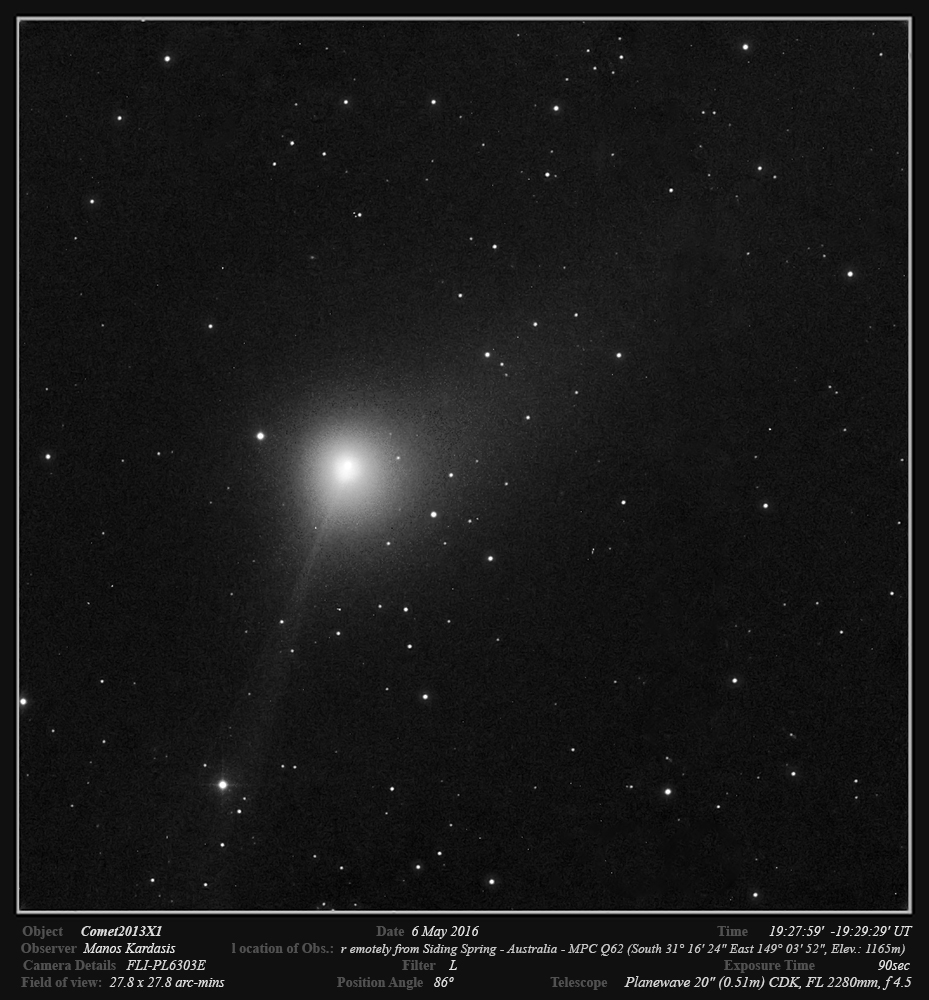ALPO COMET NEWS FOR JUNE 2016
2016-June-5
For most of 2016, there have been 2 or 3 comets bright enough for visual observers using small telescopes and binoculars. That changes this month as only a single comet is easily visible. Previously bright comets 252P/LINEAR and C/2014 S2 have now faded to fainter than magnitude 10.5. That’s still plenty bright enough for CCD observing but would require relatively large telescopes for visual observation. Luckily, C/2013 X1 (PANSTARRS) is bright at ~6th-7th magnitude this month.
Morning Comet (Jun 1-25), Evening Comet (Jun 25-30)
C/2013 X1 (PANSTARRS) [Perihelion on 2016-Apr-20 at 1.31 AU]
C/2013 X1 (PANSTARRS) passed perihelion back on April 20 at 1.31 AU from the Sun. At the time, the comet was located on the far side of the Sun. During May the comet slowly moved away from the Sun though this was more than countered by a rapidly decreasing Earth-comet distance. Between May 6 and June 5, ALPO contributors have observed PANSTARRS to be between magnitude 6.8 and 7.2. PANSTARRS starts the month in Aquarius (Jun 1-7). As it passes Earth (0.95 AU on the 1st, 0.64 AU at its closest on the 21st, and then back out to a distance of 0.73 AU at the end of the month), the comet will rapidly move through the southern constellations of Aquarius (Jun 1-7), Pisces Austrinus (7-13), Microscopium (13-18), Sagittarius (18-20), Telescopium (20-26) and Ara (27-30). Furthest southern declination will be reached on the 28th at -49°. Currently at magnitude ~7.0, X1 may brighten another 0.5 to 1 magnitude at the time of closest approach.
Manos Kardasis took this image of C/2013 X1 back on May 6 showing a thin straight gas tail and a broad sweeping dust tail.
New Discoveries
Since the last Comet Section News posting, five comet discoveries were reported.
P/2016 J1 (PANSTARRS) is not one but two comets. A single comet (component A) was discovered with the University of Hawaii 1.8-m Pan-STARRS1 telescope on May 5 UT at 21st magnitude. Follow-up observations taken the next night with the 3.6-m Canada-France-Hawaii Telescope found a second 21st magnitude comet (component B) moving with identical motion to component A. Both comets are likely related though there is some question as to whether they are comets in the traditional sense. Its orbit is very asteroidal orbit and located in the Main Belt (q = 2.33 AU, e = 0.25, i = 13, P = 5.5 yrs) so P/2016 J1 may be a case of an asteroid that recently split into two (or more fainter pieces) due to its rapid rotation. Alternately, it could be a volatile rich object that split after a recent outburst. Hopefully future large telescope observations will shed more light on this interesting object’s true nature.
C/2016 J2 (Denneau) was found by Larry Denneau as part of the ATLAS survey at the University of Hawaii. The 0.5-m ATLAS telescope was used to discover C/2016 J2 on May 6 UT at 18th magnitude. At discovery, J2 was located at 0.8 AU from the Earth. Unfortunately, J2 was already past perihelion (T = 2016 April 11, q = 1.52 AU) and past its closest approach to Earth so it has been rapidly fading. It is a long-period comet with an inclination of 130 degrees.
P/2016 J3 (STEREO) is a new low perihelion short-period comet. Scott Ferguson first spotted it in images taken on May 11 UT with the STEREO-A spacecraft located on the far side of the Sun from Earth. The comet was surprisingly bright at 8th magnitude though it appeared to rapidly fade to magnitude 13 over the course of a few days. The sharp spike in brightness is likely due to forward scattering by the comet’s dust, a condition that can greatly enhance the brightness of a comet when the phase angle (Sun-comet-observer angle) is very large. A similar event occurred to comet C/2014 C2 (STEREO) which was observed at magnitude 4 by STEREO at high phase angles but was in truth a fairly faint, no brighter than 14th magnitude, comet at normal phase angles. This new comet STEREO passed perihelion on May 21 UT at 0.47 AU from the Sun. It is a short-period comet with an inclination of 25 degrees and period of 7.7 years. Earth-based observers will have a chance to observe it this month as it moves away from the Sun in the evening sky though its brightness is very uncertain and it may be very faint, even for CCD imagers.
C/2016 KA (Catalina) was reported as an asteroidal object by Catalina Sky Survey observer R. G. Matheny. It was first observed on May 16 UT at 19th magnitude with the University of Arizona 0.68-m Catalina schmidt. Follow-up observations uncovered its cometary nature. KA is a long-period comet (T = 2016 Feb. 8 UT, q = 5.41 AU, e = 1.0, i = 104.6 degrees) and will not get brighter.
C/2016 K1 (LINEAR) was discovered on May 31 UT by the LINEAR program with the 3.5-m SST telescope near White Sands, NM, USA. It is currently an 18th magnitude comet on a long-period orbit (T = 2016 July 14 UT, q = 2.29 AU, e = 1.0, i = 90.9 degrees) and may only get a few magnitudes brighter.
As always, the Comet Section is happy to receive all comet observations, whether images, drawings or magnitude estimates.
- Carl Hergenrother (ALPO Comet Section Coordinator)




